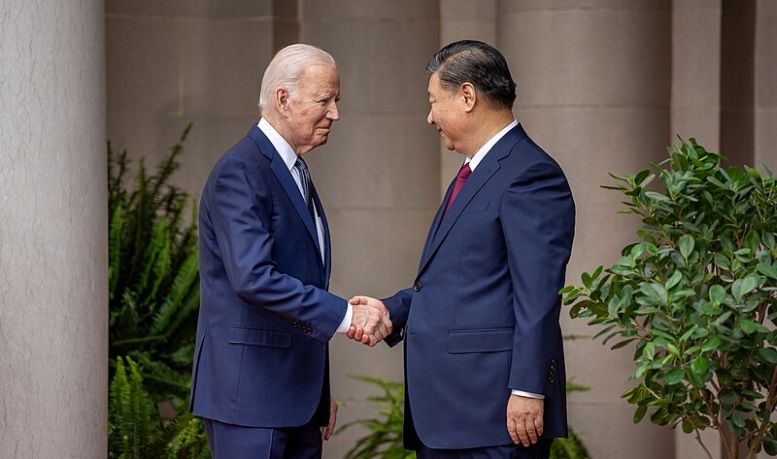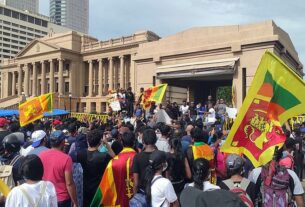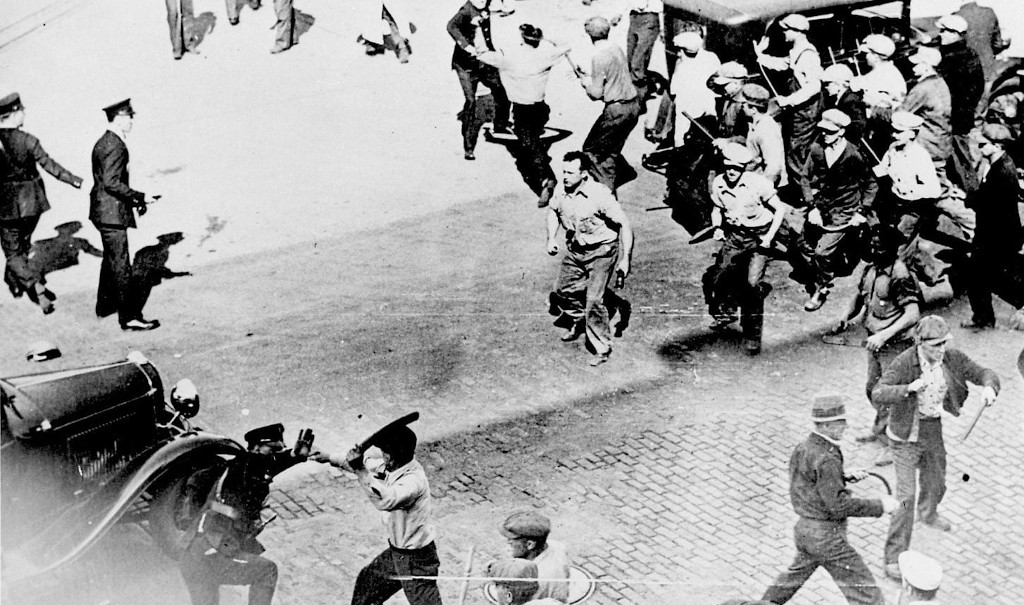The dictator-in-chief met the warmonger-in-chief on November 15, for long-delayed talks. The last time Xi Jinping and Joe Biden met was in Indonesia a year ago, when they pledged to put a “floor” under their worsening relationship. Then a Chinese spy balloon blew a hole in that floor. The US side cried foul and broke off a series of planned diplomatic exchanges.
The San Francisco talks between the two presidents, on the sidelines of a three-day APEC summit, produced very little of substance but nevertheless revealed a great deal about the real state of relations between the world’s two superpowers. Within minutes of bidding Xi farewell, Biden told a press conference the Chinese president is “still a dictator,” but claimed “progress” had been achieved in the talks. For both sides the watchword was “stabilization.” The message they want to sell to the world is that while relations between the two countries, who together account for 40 percent of the world economy, have hit rock bottom, they won’t get any worse. For now.
Accordingly, the Chinese government did not explode over Biden’s use of the D-word, as they did when he called Xi a dictator earlier this year. It was simply redacted from most Chinese news reports. One commentator on social media quipped that if Biden had called Xi an emperor, “Xi would have loved it!”
It was the Chinese side that were clearly the most upbeat about the Biden-Xi encounter. It was also Beijing that made the biggest concessions to ensure the meeting happened. A series of pre-meetings were required with Chinese officials traveling to the US to iron out details, and a definite decision over Xi’s attendance was not made until maybe three weeks beforehand.
Will he, won’t he?
A potential wrench in the works was the ban on Hong Kong’s leader John Lee (appointed by Xi) from attending the APEC summit. Hong Kong is a separate member of the 21-economy APEC bloc. Under US sanctions for his support for Beijing’s imposition of the national security law in 2020, Lee is not allowed on US territory. The US refused to back down on the issue. For a long time it seemed possible Xi would use this as a pretext to stay away, as in September, when Xi instead sent his premier Li Qiang to the G20 summit in India, a move interpreted as a de facto boycott. But in the two months that have lapsed, political realities have evidently shifted and Xi’s need to show a cooperative demeanor outweighs the need to further dial up nationalism.
The crux issue was that nothing should occur to cause Xi to “lose face” in America. Such an absurd degree of micromanagement shows how unstable and under pressure Xi’s position has become, as China’s economy tanks. One statistic reported in the Financial Times (November 19), showing the reversal of Chinese capitalism’s rise (its “Japan moment” as we have explained), is key to understanding what is happening in China today: the country’s share of global GDP has fallen from 18.4 percent to 17 percent in the past two years — something that last happened in the Mao era.
The San Francisco talks were “historic” claimed the People’s Daily, even claiming this represented “a new starting point” for US-China relations. That this statement is a million miles from reality is obvious. The summit will not lead to a “reset” in US-China relations let alone a thaw in the imperialist Cold War. The US-led chip war, anti-China trade sanctions with Europe now also getting in on the act, US-led military alliances to pin back China’s military growth, and also Xi’s countermeasures that link China more tightly with Russia, Iran and other anti-US regimes, these are still by far the dominant trend in world developments. The slaughter of the Palestinians in Gaza makes the Cold War standoff potentially even more volatile.
Excessive hype
The excessive hype in China’s media coverage shows which side wanted the California meeting most. For days before Xi’s trip, a virtual gag order was placed on anti-US rhetoric in state media. Xi’s statement that “planet Earth is big enough for both China and the US” became a hashtag on social media. While trying to project a more friendly Xi for overseas consumption, offering a welcome mat for foreign capitalists, the main focus of the CCP’s propaganda was to shore up Xi’s support on the home front.
Significantly, Xi was given no less than three standing ovations when he addressed a dinner for US CEOs in San Francisco. This gathering, attended by the usual billionaire ‘Xicophants’ like Elon Musk and Tim Cook, again demonstrated that US capitalists love dictators and that China’s Communist Party (CCP) loves capitalists. No walkabouts to meet “the people” for Xi Jinping. But the feelgood vibes on display at this dinner cannot restore the once pivotal relationship between US and Chinese capitalism which powered three decades of unprecedented capitalist globalization until this ended in the past decade.
Economic decoupling driven by the imperialist Cold War is now an unmistakable and accelerating trend. This year, barely half the manufactured goods imported into the US from low-cost Asian nations come from China, whereas four years ago the figure was two-thirds, according to Kearney’s annual Reshoring Index. “In finance, the separation is more pronounced,” says the same report. The value of US dollar foreign direct investment in China fell to $8bn last year, back to 2004 levels. In the opposite direction it’s similar: Qatar and Norway now invest more in the US than China.
Intensified power struggle
With his regime mired in economic stagnation alongside a resurgent power struggle in the CCP-state and its military arm, the PLA, Xi needed a diplomatic “success” to showcase his “skills” on the foreign stage and as a signal — however tenuous — that economic conflicts with the US can be managed and contained. Chinese media reeled out banalities such as Biden reiterating that the US “does not support Taiwan independence” as if this was a breakthrough from the talks.
The CCP’s Third Plenum meeting which according to tradition is one of the most important for announcing new economic policies, and should be held before the end of the year, was put on hold until after the Biden-Xi summit. Evidently, the plan is to create momentum from his US visit for Xi to take into the plenum. Such official manoeuvring lends weight to speculation that the internal CCP power struggle has become much sharper in 2023, despite Xi’s success at last year’s 20th CCP Congress.
It seems no amount of purges is enough. Xi has purged hundreds of very senior figures (“tigers”), and millions of low-level officials from the CCP-state in recent years, in order to consolidate his personal power base. But the social and economic crisis is creating new power struggles, political divisions and intrigues. At bottom, these pressures within the regime and capitalist class reflect alarm and deep pessimism over China’s economy and the fear of social explosions.
Missing ministers
The intensity of the latest outbreak of CCP infighting is shown by the dismissal and disappearance of two of China’s five state councillors within a few months, both close proteges handpicked by Xi. They are Qin Gang, the former foreign minister, who has not been seen since June, and ex-defence minister Li Shangfu, who disappeared down the same CCP rabbit hole in August. Both men are under investigation, in Qin’s case for alleged “national security violations” and in Li’s case, probably for corruption (not yet officially confirmed). Such charges are standard in CCP purges, but usually hide political violations such as conspiring, challenging or compromising the authority of the top leadership.
In Qin’s case, if we overlook the CCP’s “morality police” and charges of having an extra-marital affair when he was ambassador to the US, the most likely explanation for his downfall seems to be his mishandling of diplomatic exchanges with the US in the aftermath of the balloon saga. After several fits and starts, US Secretary of State Antony Blinken went to Beijing in June on a mission to “stabilize” relations and lay the ground for a new Biden-Xi summit.
But the Americans were incensed by a perceived sleight when Blinken met Xi Jinping in Beijing and was seated far away from him, at an unusual horseshoe shaped table, as if the seating plan had been inspired by a famous scene in Charlie Chaplin’s movie, The Great Dictator. It was Qin, the foreign minister, who organised the seating plan and the Americans were clearly not impressed.
Days after this, Biden called Xi a “dictator” at a campaign fundraiser. In the same speech he said, “The reason why Xi Jinping got very upset in terms of when I shot that balloon down with two box cars full of spy equipment in it, he didn’t know it was there.” This statement — likely true — will have stung the Chinese president more than being outed as a dictator. Whether or not Biden’s speech was a deliberate rebuke for the lack of courtesy shown to Blinken, this is how it was received in China. Four days after this, Qin Gang joined the ranks of China’s disappeared.
This is probably because a layer of CCP officials feared Qin’s approach was too aggressive, which risked an even bigger backlash from the US. We see that in such a high-pressure environment a relatively small diplomatic mistake can lead to the removal of an official in public, which even the “emperor” Xi cannot smooth over. This underlines how volatile the situation has become at the top of the CCP-state.
The rival faction against Xi, led by the late Li Keqiang, was basically broken after the 20th Congress last October. The old pattern of power struggles led by different factions is over. The opposition to Xi is scattered in different parts of the state. But paradoxically this makes the current power struggles, which are no longer factionally organised, less predictable and harder to contain from the public. A further example is the publication in the media of new Premier Li Qiang’s considerable wealth. Under China’s total media control it is very likely this too is an expression of a power struggle within the state.
Pressure on Biden
As the year draws to a close, the US side has also come under pressure to secure a meeting with Xi, to tamp down fears among some important US allies, and also on Wall Street, over whether the US-China conflict is barrelling out of control into possible military confrontation. While the US economy, despite obvious frailty, might not be in a desperate Japan-like rut like Chinese capitalism, Biden faces mounting challenges ranging from Israel’s strangulation war against Gaza and stalemate in Ukraine, to a resurgent Donald Trump (leading Biden by 2 to 4 percentage points in opinion polls).
As in their meeting in Indonesia, the US side talks about establishing “guard rails” to limit the confrontation, “so it doesn’t veer into conflict or accidental conflict” as Biden told Xi in San Francisco. In reality, the struggle between the two imperialist giants is escalating and such phrases are just sedatives to make onlookers believe these governments are — contrary to all evidence — “responsible” and in full “control.”
The two presidents did agree some modest but rather vague deals to support the “progress” narrative. Military-to-military contacts are to restart, after they were halted by China in protest against Nancy Pelosi’s 2022 visit to Taiwan. Even here, Beijing insisted on writing “on the basis of equality and respect” into the deal, signalling even this is on shaky ground. It was also agreed to set up a “working group” to combat the flow of fentanyl into the US from China and another to discuss the risks with AI.
Beyond the misleading optics of the Biden-Xi summit, the real world is in a more dangerous place than even a year ago. The Cold War between US-led and China-led blocs shows no meaningful signs of de-escalation. The arms race is quickening in Asia and a flood of protectionist policies is coming out of Washington, Beijing and Brussels. In October, Biden strengthened US tech sanctions against China. Both sides present a facade of “talking” while beefing up their Cold War strategies.
Not enough concrete measures to reduce the confrontation was the verdict of veteran China reporter Katsuji Nakazawa (Nikkei Asia, November 17). “It was barely enough for Xi to save face,” he added. “The question now is how long the US-China detente will last. Half a month? One month? Maybe three?”




